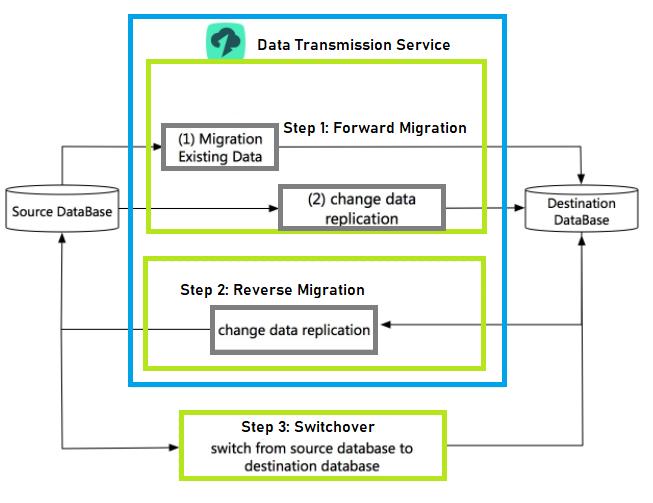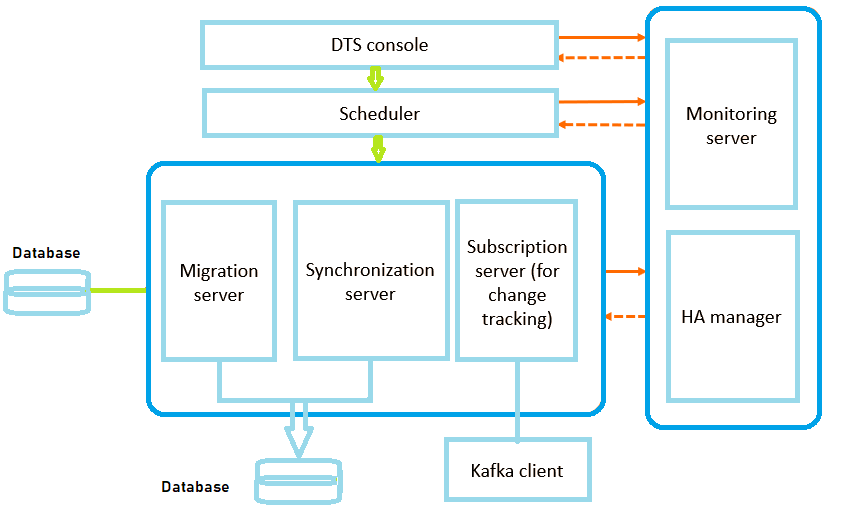This article explains what the Data Transmission service is and how you can use it to the fullest.
Data Transmission Service (DTS) is a fully managed data replication service that supports a variety of operations and modes. Migrations between relational databases, data warehouses, and NoSQL databases are all supported. The Data Transmission Service (DTS) allows you to transfer data incrementally from on-premises to the cloud and from cloud to cloud.
Data Transmission Service (DTS) supports multiple replication modes to replicate data:
The Alibaba Cloud Data Transmission Service (DTS) has an architectural flow that supports dual redundancy features. All of the functions of DTS are deployed on multiple servers that have dual redundancy. Let's take a look at each module to understand how it functions:
Let's take a look at the architectural flow:
This article describes how to use DTS to synchronize data from an ApsaraDB RDS for MySQL instance to an Alibaba Cloud Elasticsearch instance in real-time.
Data Transmission Service (DTS) synchronizes production data from an ApsaraDB RDS for MySQL instance to an Alibaba Cloud Elasticsearch instance in real-time after you create a real-time data synchronization task in the DTS console. This article focuses on the various supported real-time synchronization types and SQL operations. It further elaborates on the configuration procedure to support synchronization.
Real-time data synchronization from an ApsaraDB RDS for MySQL instance to an Alibaba Cloud Elasticsearch instance in the same Alibaba Cloud account.
Supported SQL operations include:
1. Inset
2. Delete
3. Update
Note: Currently, DTS does not support Data Definition Language (DDL) synchronization and ignores DDL operations during synchronization.
In case a DDL operation of a table is encountered, the Data Manipulation Language (DML) operation of the table may fail. To rectify the failure, follow the steps below:
1) Delete the table from the synchronization object list. For more information, see "Remove an object from a data synchronization task.
2) Delete the index corresponding to this table in the Alibaba Cloud Elasticsearch instance.
3) Modify the synchronization task, re-add the table to the synchronization objects, and re-initialize the table. For more information, see "Add an object to a data synchronization task."
If a DDL operation is used to modify a table and add a column, the recommended DDL operation sequence is as follows:
1) Modify the mapping of the corresponding table and add a new column in the Alibaba Cloud Elasticsearch instance.
2) Modify the table structure and add a column in the source ApsaraDB RDS for MySQL instance.
3) Pause and restart the DTS synchronization task to allow DTS to reload the modified mapping in the Alibaba Cloud Elasticsearch instance.
Data Transmission Service (DTS) helps you migrate data between data storage types, such as relational database, NoSQL, and OLAP. The service supports homogeneous migrations as well as heterogeneous migration between different data storage types.
DTS also can be used for continuous data replication with high availability. In addition, DTS can help you subscribe to the change data function of ApsaraDB for RDS. With DTS, you can easily implement scenarios such as data migration, remote real time data backup, real time data integration and cache refresh.
Data Transmission Service (DTS) supports data replication in several modes, including data migration, change tracking, and data synchronization. You can use a combination of data replication modes that best suit your use cases.
This topic describes the supported data migration paths (source-target pairs) and replication features of all replication modes. For each migration path, the supported cloud-based and user-created databases and their corresponding replication features are listed.

2,599 posts | 765 followers
FollowAlibaba Developer - June 19, 2020
Alibaba Clouder - April 2, 2019
Alibaba Clouder - March 30, 2018
Alibaba Clouder - February 14, 2020
Alibaba Developer - February 1, 2021
Alibaba Cloud Community - October 29, 2024

2,599 posts | 765 followers
Follow Data Transmission Service
Data Transmission Service
Supports data migration and data synchronization between data engines, such as relational database, NoSQL and OLAP
Learn MoreMore Posts by Alibaba Clouder